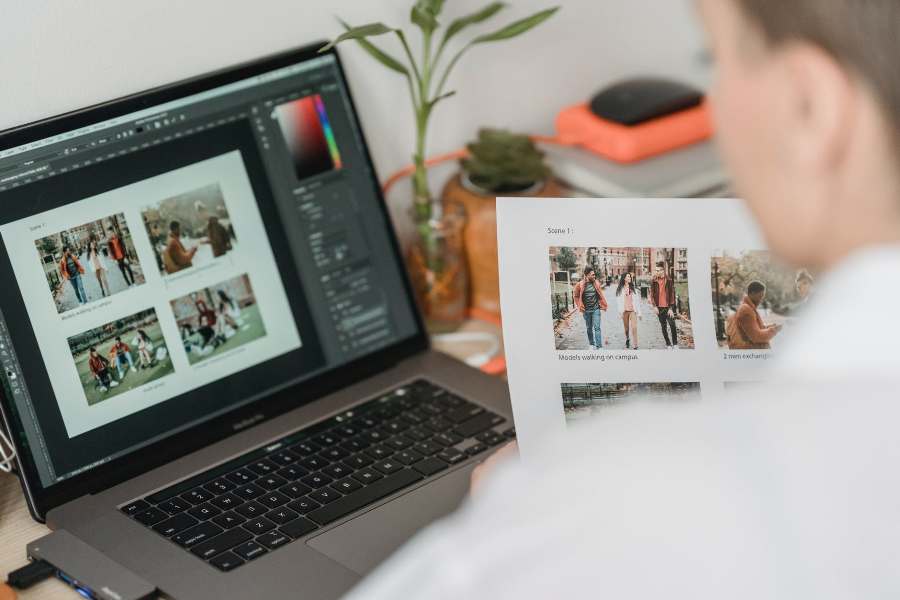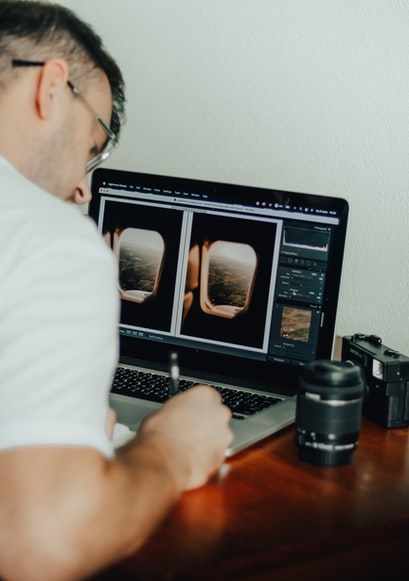
As an Amazon Associate we earn from qualifying purchases.
Photo editing is an important process in producing amazing photos. It is more than just placing an aesthetically pleasing filter over your image, it’s a whole technical process.
However, learning how to edit pictures properly is a skill that needs to be mastered so you can turn your good pictures into incredible ones.
Two tools that professional photographers use for photo editing are Affinity Photo and Photoshop. When it comes to Affinity Photo vs. Photoshop, which one is better suited for professional photographers?
Quick Navigation
Adobe Photoshop was launched in 1988, and it immediately became the most popular digital image editing tool around the world. This software is the standard for industry-leading professionals and beginners alike.
Photoshop's success has resulted in the creation of many competitors, including Affinity Photo. Affinity Photo is an alternative for Photoshop especially for those who want an image editor that’s rich in features yet not complicated to use. With Affinity Photo's easy-to-operate environment, is it now a better choice? Or is it better to stick with Photoshop?
When choosing between the two photo editors, it is important to remember that there is no single correct program for all editors and photographers. Each photo editor tool has advantages and disadvantages, they have very different models, and they both work really well for photographers.

Affinity Photo was created by Serif in 2015. With its easy-to-use features and interface, it got an App of the Year award in 2015.
Affinity Photo can be purchased in the iOS App Store, macOS App Store, and the Microsoft Store. This software comes packed with plenty of features that make it stand out from the other editing tools on the market.
Affinity apps are available for Windows, and Serif is trying to make inroads on Photoshop's firm grip on the software industry. Serif's user-friendliness is an important factor for some editors.
The latest version of the tool has hardware acceleration or improved performance on Windows, including linked layers, custom interface presets, and astrophotography stacking.
Affinity apps have numerous powerful features, yet some of them are a bit slow, and the user interface still lacks in some areas compared to its competitors. Several of the program's features fall short of Photoshop's state-of-the-art software.
If you wish to use the desktop software, you can download it via the app stores. The desktop software has a very simple installation and update process, and it can be accessed across numerous computers.
The download on desktop computers will take up 530MB, and the program will take up to 711MB of space after it is installed and running. By comparison, Photoshop takes up 2GB.
When you first run the Affinity app, you will see the Welcome panel, and it will offer sample images, tutorials, and even links to Facebook and Twitter content.
The program’s interface may be on the darker side, yet it has a lot of colorful icons you can choose from, and they are less understated compared to other photo editing apps.
As with Photoshop, the app has a toolbar row located at the left side of the window. It has an info panel that is located at the right side. The info panel has Swatches, Layers, Histogram, Adjustment, Transform, and 25 options, all of which can be undocked.
Above the image view, you will see buttons for five modes. The default modes are:
You also have Panorama, yet it is only visible when you are stitching dozens of images at once.
Personas are equal to workspaces. Affinity lets you customize your workspace and change its colors and lets you save all of the customizations that you’ve done.
You can also zoom in using the mouse wheel and the Ctrl key, and you can double click so you can switch back to Fit view. Affinity Photo interface feature is also equipped with a double-clicking slider that immediately sets your workspace back to its original look.

Another feature that users like in Affinity is the side-by-side and split views that show the before and after edits of your images. Unlike other apps, Affinity has no full-screen view, you need to click on a Tab for a better screen and hide the interface elements.
Affinity Photo supports a selection of keyboard shortcuts, yet it does not have many shortcuts for context menus.
Adobe Photoshop is an important tool for photographers, designers, web developers, and graphic artists. It is used for image editing, creating picture compositions, image retouching, adding photo effects, and creating websites.
Photoshop is currently the most popular editing tool among photographers and graphic designers, and below are the reasons why it is so well-received.
Photoshop offers its users the ability to edit, create, and enhance their images, illustrations, and artwork. You can change backgrounds, simulate real-life painting, or create an alternative view of the environment.
It is the most popular software tool for image manipulation, photo editing, and retouching for images and video file formats. The tools within the software make it possible to edit individual images as well as massive batches of photos in no time.
Photoshop has its own subscription, and it includes Lightroom and the Creative Cloud or CC subscription.
A Photoshop subscription costs $20 a month, while the Photoshop Creative Cloud costs $52.99 a month and the Photoshop Lightroom costs $9.99.
The subscription will give you 20GB of cloud storage, which means it can store up to 4,000 JPEGs. If you wish to increase the storage to 1TB, it will cost you an additional $19.99.
When you create a document in Photoshop, you can select from a wide range of templates so you don't begin with a blank canvas. The templates include assets and illustrations that you can work on to complete your work.
When you open a template, you can tweak it and make necessary adjustments just as you would with any other document in Photoshop. The templates open as .psd files and they include multiple artboards.
Aside from templates, you can also create a document by choosing one of the many presets available or you can create your custom sizes. Photoshop lets you save the presets for future use. The templates and the presets are categorized into the following sets:
Photoshop Elements, on the other hand, is a version of the program that is leaned towards consumers. Elements have a lot of features and capabilities that are similar to Photoshop CC, yet they have a more simple option as it has beginners in mind when it was designed.
More specifically, it is created for new digital photographers and videographers. Elements are created using Photoshop CC’s image technology.
The commonly used capabilities of Elements include cropping pictures, manipulating the color of a picture, repairing the flaws, drawing on an image with a pencil or pen, adding texts, removing objects within a picture, organizing photos, and publishing images online.
Adobe Photoshop is a highly detailed program that offers a great mix of photo editing and raster graphics tools. It is a software for creating digital art, marketing media and
Meanwhile, Affinity Photo is an alternative to Photoshop for those who can't register for a subscription. It also has a great set of features and tools that can edit RAW photos. It also does not require high-specs to work, so it is ideal for those who have a computer that can't run Photoshop.
Choosing which one to use can be challenging, so to give you a clear idea of the comparison, I have broken it down into different sections. You can see what makes them similar and what makes one program better than the other.

Photoshop and Affinity Photo are both editing software, which means that they are bound to have some similarities especially when it comes to their tools. Here are some of the features and capabilities that you can find on both software.
What the two photo editing programs lack is a set of photo management tools. Although users may not look for any photo management option, there are those that have a massive photo collection that they need to edit, and these tools are very useful in successfully changing them.
Affinity only lets you open and save your pictures. You can also do basic photo management by making new folders in your dialogue box's main file. However, that is all that it offers. For you to be able to manage your images, third-party software for photo management is needed.
As for Photoshop, it also lacks management tools, which is why Lightroom was created. If you have Lightroom installed, you can easily transfer your images into the program as soon as you are done editing them. You can also organize your files using Adobe Bridge for free as part of your subscription.
A RAW file is the raw image that you get straight from the camera. It is like a blank canvas where you can make all of the adjustments and changes that you want so you have the final say on what the picture will look like.
Both of the photo editing tools have amazing RAW tools.When you edit a RAW file, all of the adjustments are saved in the RAW editing software and not on the file itself. In this way, you can always go back to the beginning or you can make different edits to the same image. .
Affinity is equipped with a set of tools in the Persona option made for RAW images. You can edit the picture's parameters like saturation, contrast, and balance. The different parameters are divided and they can be found in the clear tabs. You can select presets for each of them if you wish to change your photos and switch them to a certain style.
Affinity has four different automatic editing options; they are auto contrast, auto levels, auto white balance, and auto colors. These options offer one-click edits on pictures and it will improve the quality of your images.
Photoshop, on the other hand, has two methods made for RAW editing. You can use numerous toolbars located on the right side, like colors, properties, and adjustments. It lets you adjust the parameters and the quality of your images. The tools also have amazing details and control over your pictures.
If you wish, you can download the plugin called Camera Raw. This plugin is within the Photoshop program that is included in the package. It opens a dialog box and you can control your RAW editing in better detail than the basic tools offer.
Several users find plugins easier to use than the toolbars in the standard program's layout. Camera Raw lets you adjust things easily like lens correction, vignetting, and calibration.
As for creative effects, both editing tools have a great selection. For both tools, you can add effects and filters to your images like noise, blurs, distortions, and sharpening. The tools are very easy to use and operate, and both tools appear to produce great results.
Although both of the photo editing software have creative effects, Affinity Photo has a bit of an advantage because it has a wide range of styles that apply edits to your images. These styles are diverse and they are better suited for making marketing pieces or images.
You can also control the filters that are placed on your images. The filters are applied to your images easily. However, the most impressive thing about Photoshop is its ability to add features. You can download and connect numerous filters from third-party apps by installing them and applying them to your images.
When choosing which photo editing software to use, it is important to know what sets Photoshop apart from Affinity Photo and vice versa. Below are the differences that you can take note of so you will know what to expect when you decide on software.
When it comes to editing tools, the most vital thing to consider is their overall performance. When working with massive files, you want your editing program to run smoothly.
You do not want to have to purchase a whole new computer just to add more storage space and accommodate the tool and you do not want to spend so much time waiting for the program to download and function.
Both tools have different system requirements. For Photoshop, the requirements are the following:
For Affinity Photo, the requirements are the following:

A photo editing software's usability should be considered. Its usability depends on your skill and your overall experience with editing. If you use the program often, you should not have a problem using either tool. However, if you are new, then both tools can be overwhelming to use.
Affinity Photo is a much better choice for beginners because it is easier to navigate. It also does not take a lot of tutorials to understand how everything works as all of the tools are already laid out for you.
Photoshop, on the other hand, is filled with numerous advanced tools that can cause confusion when editing images. It is a piece of software that is suitable for professional photographers and web designers that need more effects and edits on their work.
Affinity Photo is the editing software that comes the closest to being able to compare to Photoshop when it comes to functionality. The major difference between the two is that 95% of the features on Affinity Photo stay in the same spot, while in Photoshop, there are lists that you need to check on before you get the function that you need.
Affinity Photo has a live preview that lets you see what you are doing as you apply the effects. Plus, Affinity Photo does not have a lot of requirements so you can download it and run it on any computer.
In Photoshop, you still need to go through numerous palettes and sections just so you can apply effects on your images, which can be confusing for those who are not familiar with the software. It also has a lot of requirements for it to run properly on a computer.
Affinity Photo has features that can defeat Photoshop. It has a non-destructive resizing function that is easy to operate and you don't have to convert the images to Smart Object just to resize them, unlike in Photoshop. Also, the layers can be resized without having to sacrifice the quality of the image.
You can use Affinity Photo if you are a beginner in graphic design and photo editing. Affinity Photo is easier to learn compared to Photoshop. The tools are not as complicated to use and everything that you need is placed in one section, so you won't have to go back and forth between windows just to apply effects.
Photoshop is popular for a reason. It is equipped with all of the tools that you need in order to change almost anything in an image. You can resize it, crop it, cover any blemishes, retouch it, and more. You can also add any element, text, or effect that you want because it has a layered tool.
The layers can work on multiple files. You can build on single elements and combine them later on. You can isolate an image and work on it so you won't have to work on a large, stand-alone file. If you wish to be able to edit images in a more detailed way, then Photoshop is for you.
Photoshop is a standard tool in the industry because it can work on everything, from photo editing and graphic design to animation and digital painting. Affinity Photo, on the other hand, is an image editing software that can provide a series of necessary features and functionalities.
Overall, Photoshop is the better program among the two because of its wide range of features. It can also be used in every single setting, may it be a quick edit or designing a new website. Photoshop remains the most powerful graphics editor, and if you are a professional photographer or web designer, there is no better tool to use than this.
